What grade do you give George Kliavkoff for his first two-plus years as Pac-12 commissioner? — @Jalex0077
How does Kliavkoff still have a job? — @benwilkinson
Let’s address the second question first: He remains employed because the conference needs someone to handle day-to-day operations for the upcoming competition year.
Also, because his buyout likely would approach $10 million, assuming he signed a five-year deal in 2021 for about $3.5 million annually.
If they have to pay him anyhow, why not let Kliavkoff oversee operations?
He is not heavily involved in strategic matters for the remaining schools, according to sources. Stanford, Cal, Washington State and Oregon State are plotting their paths, individually and collectively, without him.
Any serious rebuild of the conference — the next move depends on the Bay Area schools — assuredly would take place under different leadership.
In terms of his job performance, the grade is obvious.
Kliavkoff’s primary task was to secure a lucrative media rights deal that would keep the conference together and position the schools for long-haul success.
“George is a visionary leader with an extraordinary background as a pioneering sports, entertainment and digital media executive, and we are delighted and honored that he has agreed to become our next Pac-12 Commissioner,” Michael Schill, the former Oregon president and Pac-12 board chair, said on the day Kliavkoff was hired.
“He is the new prototype for a sports commissioner. While George has deep sports experience, his biggest asset is his ability to listen, connect with diverse groups, find common ground, collaborate and navigate an evolving landscape.”
Here we are, 27 months later, and the Pac-12 has become the Pac-4 and could soon be the Pac-0. Kliavkoff could not lead the presidents down the path to smart strategy, he lacked the urgency necessary to survive realignment, and he misread the intentions of his constituents on multiple occasions.
Yes, Fox’s strategy created a difficult negotiating landscape; the Pac-12 presidents were arrogant and out of touch; and the presence of two schools with value to the Big Ten (Oregon and Washington) created massive instability.
In contrast, the Big 12 had none of those burdens to bear.
Kliavkoff doesn’t deserve all the blame, not by any stretch. Responsibility starts with the collection of presidents who ruled the conference ineptly for a dozen years, and former commissioner Larry Scott set the strategies that led the Pac-12 down the road to destruction.
But Kliavkoff had a singular mission, to land the media rights deal, and he failed. The collapse of a 108-year-old pillar of college sports occurred on his watch. He’s accountable. His grade? F, of course.
In our view, Kliavkoff is a deeply decent individual and smart business executive who was poorly suited for the task assigned by the presidents and the search firm of record, Turnkey ZRG.
The athletic directors, who know the challenges on the front lines, were not heavily involved in the hiring process — yet another blunder by the presidents.
How a collection of super-sharp individuals responsible for multi-billion-dollar universities could make so many bad strategic decisions over so many years would make for a fascinating case study.
Why haven’t Fox and the Big Ten offered membership to Stanford without Cal? The Big Ten had an odd number of teams for many years after Penn State joined in the early 1990s. This would leave an open spot for a better program than Cal. — @tgbegreen
Stanford clearly has more prestige and media value than Cal within the college sports space, and some believe the Big Ten is waiting on Notre Dame before it moves on the Cardinal. Once the Irish agree to give up Independence, they would join the Big Ten along with Stanford.
However, the additions of Washington and Oregon might change the calculation.
For scheduling purposes, a six-team western arm makes more sense than a five-school construction; three sets of travel partners in the Pacific Time Zone would be more efficient than two.
It all depends on Fox, which controls the Big Ten’s media rights and thus directs the expansion strategy.
We suspect the Cardinal and Bears would use invitations from the ACC — if they ever come — to leverage offers from the Big Ten, their preferred destination.
The prospect of the Bay Area schools joining a conference aligned with ESPN could be the only way to lure Fox out of its hole.
Could the remaining Pac-12 members merge with both the Mountain West and American conferences? Is there enough incentive to aggressively expand and try to win money from networks on quantity of games over quality of brands? — @LukeTCoug
A full-on merger, which would create a super-mega conference of 20-something schools, is not plausible in our estimation.
It makes far less sense competitively, logistically and financially than a reconstituted Pac-12 that would feature the top football programs and media markets in the other two leagues.
Of course, the Pac-12 schools must have something to offer above and beyond what the likes of San Diego State, Fresno State, SMU and Tulane would have in their current conferences.
In other words: a more lucrative media rights deal.
What is the minimum media revenue required for each of the ‘Pac-4’ schools to produce a viable athletic department? — @RockDawg3
Depends on how you define viable.
San Diego State’s football program has won 10 or more games five times in the past decade and its basketball team just reached the NCAA Tournament finals. The Aztecs’ operating budget last year was $67 million (according to USA Today’s financial database).
That includes the Mountain West’s media rights contract with Fox and CBS that spins off approximately $5 million per school per year.
Meanwhile, the Cougars and Beavers had operating budgets in the $85 million range with a media deal that paid about $25 million.
The difference? SDSU relied more heavily on support from central campus.
Whether WSU and OSU are members of a rebuilt Pac-12 or enter the Mountain West, their media revenue will plunge.
If the administrations are willing to lend necessary assistance, their budgets should support success in any scenario.
What will happen to Cal, Stanford and the Pac-12 if Oregon State and Washington State get tired of waiting and jump ship for stability? I understand it is unlikely but am interested in your take. — @FryEthO
I consider that scenario extremely unlikely — to the point that we haven’t given it much thought.
Washington State and Oregon State prefer to remain under the Pac-12 banner, with the Bay Area schools, and rebuild the conference by picking off the Mountain West and perhaps the American.
That course of action would better serve both their football brands and athletic budgets than joining the Mountain West.
How long before the top football programs remove themselves from the conferences and become one collective, separated into geographical divisions? — @seanyodarouse
Removing football from the NCAA sports structure makes all the sense in the world, and on Thursday the influential Knight Commission on Intercollegiate Athletics reiterated its call for football to be treated independently:
“The recent conference realignment decisions of six Pac-12 institutions, including two founding members of the 108-year-old conference, should be the final tipping point forcing university presidents to explain why the current structure is still in the best interests of all Division I college athletes in all sports.
“These football-driven realignments create substantial challenges for basketball and Olympic sport athletes, who will spend much more time traveling and will miss many more classes with cross-country conference competition than football players.
“The Knight Commission believes our December 2020 proposal for an overhauled structure will be better for athletes in all sports and improve governance. Our proposal calls for the creation of a new governing structure solely for the sport of FBS football, with the NCAA continuing to govern all other sports.”
Will anyone listen? Probably not.
There have been conflicting reports about Oliver Luck and whether or not he is consulting for just one school, multiple schools, or the conference. Who does Luck currently tender services to? — @AmbitiousCoug
My understanding is that Luck has been retained by Washington State and Oregon State, not the Bay Area schools.
Looking back over the Pac-12’s pursuit of a media deal, would you have done anything differently in reporting on the story? — @nickbeatty72
No topic is more difficult to cover than realignment because of the secrecy involved and the complicated decisions that shape the process.
Would we take a few do-overs? Of course.
The Hotline clearly missed on several details (the timing of a resolution, the expansion imperative and Amazon’s role, to name three), but that comes with writing weekly about an intricate topic over the course of 13 months.
On the issues that ultimately shaped the crisis and determined the outcome, we were either spot-on or within reasonable range:
— Despite the noise from the Big 12, we said all along that the Big Ten was the primary existential threat.
This was clearly the case. Without the escape hatch provided by Fox and the Big Ten presidents early the morning of Aug. 4, Oregon and Washington would have signed the grant-of-rights and the conference would be intact.
— We wrote repeatedly that the Four Corners schools wanted to remain in the Pac-12 and would jump to the Big 12 only if they had no choice.
Yes, Colorado, which spent 60-something years in the Big 12, left a little early (after waiting 12.5 months). But the others were prepared to sign the grant-of-rights on the fateful Friday before Oregon and Washington derailed the plan.
(The key to that bond, as we suspected all along, was Arizona State president Michael Crow.)
— We wrote the Pac-12 and Big 12 carried roughly the same media valuation, with a slight edge to the latter because of its basketball brand.
This was certainly the case last fall, when the Pac-12 rejected an offer from ESPN for approximately $30 million per school and the Big 12 signed with ESPN and Fox for $31.7 million. Once the Pac-12 passed, the market moved.
However, it’s difficult to compare Apple’s offer of $25 million in guaranteed cash to the Big 12’s deal because we don’t know the mechanics of the incentive clauses. (Our suspicion: The first subscription trigger would have been easy to reach, thereby placing the Pac-12’s revenue on the same level as the Big 12 schools by Year 3.)
— We maintained throughout the process that the media rights deal would carry a heavy streaming component but needed a linear piece — specifically, a connection to ESPN — or it would be poorly received by the membership.
What happened? Several schools, including Washington, were less than thrilled with the structure of the deal and the lack of guaranteed linear access.
— The Hotline point spread never suggested a deal was guaranteed. We installed survival as a 5-point favorite over extinction through the winter and only a 4-point favorite from March through late July.
That line equates to a probability of 60 percent, or slightly better than 50-50.
Regular readers of our content were aware of the uncertain outcome. That survival was far from guaranteed. That nothing mattered until the schools signed on the bottom line.
As we wrote in January and referenced repeatedly throughout the winter and spring: Time and risk move together in the realignment game.
The longer Kliavkoff waited, the greater the risk of an extinction event … like the Big Ten regaining its thirst for expansion.
Related posts:

(AP Photo/Marcio Jose Sanchez)
Wilner – Power Five revenue projections for FY2023: Comcast mess leaves Pac-12 far behind
(AP Photo/Lucas Peltier)
Pac-12 media deal coming in ‘near future,’ commissioner George Kliavkoff says in rare public remarks VIDEO – Wilner/Cesmat Emergency chop-up on Pac-12 demise
VIDEO – Wilner/Cesmat Emergency chop-up on Pac-12 demise

(AP Photo/Darryl Webb)
— Pac-12 finances: Estimating the NCAA Tournament cash available for the remaining schools

